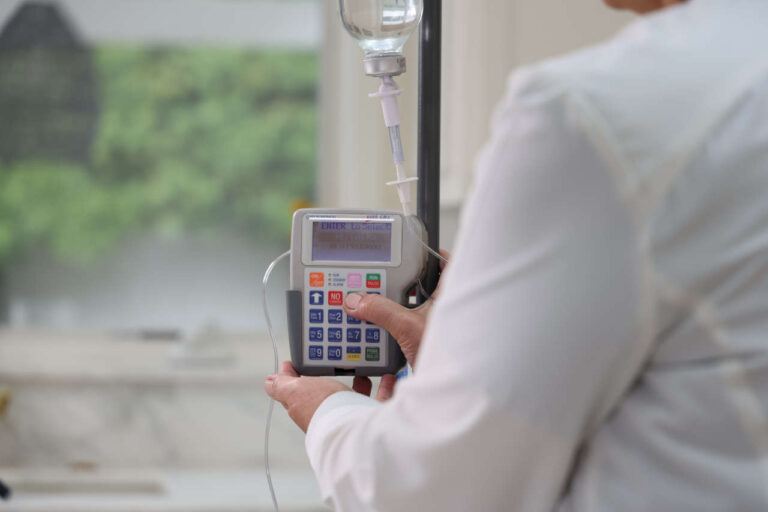
IVIG for primary immunodeficiency is an FDA-approved treatment. It increases the user’s lifespan, improves their quality of life, and keeps them infection-free to the maximum extent possible.
Ask About IVIG Home Infusion
Primary immunodeficiency (PI) is a blanket term. It covers over 400 rare, long-term conditions that make you more likely to get recurrent or severe infections.
Primary immunodeficiency occurs when you lack a part of the immune system or your immune system doesn’t work as it should.
Other names for this condition are:
- Primary immunodeficiency disease
- Primary immunodeficiency disorder (PIDD)
- Inborn errors of immunity (IEI)
PI is rare, affecting 1 in 2,000 individuals in the US [1].
How Does It Work?
Individuals with PI have deficient or dysfunctional antibodies. Replacing them with externally administered immunoglobulins (such as IVIG) is the standard treatment. Immunoglobulins are infection-fighting proteins that are also called antibodies.
IVIG (Intravenous immunoglobulin) contains donor-derived immunoglobulins. These proteins strengthen your immune system and prevent infection-related deaths. IVIG is given via a needle inserted into a vein.
Subcutaneous immunoglobulin (SCIG) is another way to replace deficient or dysfunctional antibodies. It involves administering immunoglobulins into the fatty layer of tissue below the skin.
Also Read: SCIG vs. IVIG: Which Treatment Is Best for You?
Both IVIG and SCIG are highly effective in treating PI. However, the route of administration and the specific IVIG products you use depends on your response and preference. Thus, it’s crucial to discuss a particular treatment and potential side effects with your prescriber.
According to a 2019 analysis, individuals with PI on home IVIG versus SCIG had comparable health-related quality of life. Among those receiving immunoglobulins for the first time, a larger improvement was observed in those starting with SCIG [2].
Each IVIG product is unique, and no generic versions are available. Thus, IVIG products shouldn’t be interchanged.
Top 5 Benefits of IVIG for PI

- It increases the lifespan of the user.
- It improves quality of life.
- It keeps the patient infection-free to the maximum extent possible.
- It prevents organ damage due to recurrent infections.
- It reduces hospitalizations.
How Much and How Often To Take IVIG for Primary Immunodeficiency
The starting IVIG dose for PI is 400 – 600 mg/kg every 3 to 4 weeks. Repeated doses at regular intervals are necessary because the body uses up externally administered antibodies for normal bodily processes. Since IVIG doesn’t stimulate the immune system, constant replenishment, usually for a lifetime, is essential.
Get IVIG Financial Assistance
When You Shouldn’t Receive IVIG for Primary Immunodeficiency
IVIG products have no absolute contraindications. Yet, they must be avoided or used with caution in certain situations.
For example, anyone with a history of severe, life-threatening reactions to human immunoglobulin shouldn’t receive any IVIG product. The same holds true for IgA-deficient individuals with antibodies to IgA and a history of hypersensitivity.
Avoid taking Octagam, an IVIG brand, if you’re allergic to corn. It contains maltose, a sugar obtained from corn.
Avoid using another IVIG product, Gammaplex, if you have a hereditary fructose intolerance.
Infants and neonates with no established sucrose or fructose tolerance shouldn’t receive this product.
Individuals with renal failure or diabetes should avoid using sugar-stabilized IVIG products.
Hyperosmolar IVIG products shouldn’t be used in post-transplantation patients due to the risk of kidney problems.
If you have heart disease or high blood pressure, use caution and monitor closely when taking products high in sodium.
How Much Does IVIG for Primary Immunodeficiency Cost?
The amount you pay for IVIG treatment can vary, depending on your insurance plan, geographical location, and pharmacy. Contact your insurance provider to learn if your plan covers this medicine or if you need prior authorization.
Contact us to learn how you might be able to reduce the cost of IVIG treatment.
REFERENCES:
- Prince, B., Lecerf, K., Mustillo, P., & Scherzer, R. (2020). Incidence of primary immunodeficiency disorders at a tertiary care immunology clinic. The Journal of Allergy and Clinical Immunology, 145(2), AB31. https://doi.org/10.1016/j.jaci.2019.12.822
- Anterasian, Christine et al. “Quality of Life Differences for Primary Immunodeficiency Patients on Home SCIG versus IVIG.” Journal of clinical immunology vol. 39,8 (2019): 814-822. doi:10.1007/s10875-019-00705-5













